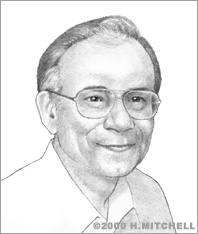Ananda Chakrabarty
Ananda Chakrabarty, PhD is a distinguished professor of microbiology and immunology at the University of Illinois College of Medicine (UIC). Though his career spans several decades, his most notable creation is a biology-based solution for cleaning up toxic spills using Burkholderia cepacia, or B. cepacia. The solution has the potential to degrade environmental pollutants such as Agent Orange.
Chakrabarty earned his PhD at the University of Calcutta in India in 1965. In his days as a young scientist at General Electric here in the United States, Chakrabarty developed the B. cepacia bacterium in his laboratory. The bacterium has the ability to break down crude oil into simpler substances that can serve as food for aquatic life. B. cepacia was the subject of a landmark 1980 U.S. Supreme Court decision that said forms of life created in the laboratory can be patented.
In “Diamond vs. Chakrabarty,” the U.S. Supreme Court held with a five to four vote that living, man-made microorganisms are patentable. The court ruled that patents could be issued for "anything under the sun that is made by man."
In upholding Chakrabarty's position, Chief Justice Warren Burger wrote, "the relevant distinction is not between living and inanimate things," but rather between naturally existing and human-made inventions. Because Chakrabarty's bacterium was created in a laboratory through cross breeding, it was not "nature's handiwork," the court said, but rather the product of "human ingenuity and research." The decision served as a precedent for the issuing of patents on mice, pigs, and cows, some containing introduced human genes, as well as naturally occurring human bone-marrow cells.
At one time shortly after the decision came through, a spokesman for Genentech, a San Francisco company formed by Robert A. Swanson and biochemist Dr. Herbert W. Boyer to exploit the possibilities of gene-splicing techniques, said the Supreme Court's action had "assured this country's technology future." Many say that Chakrabarty’s battle for patent protection paved the way for future patenting of biotechnological discovery.
Chakrabarty's career illustrates a talent for turning research into practical means.


